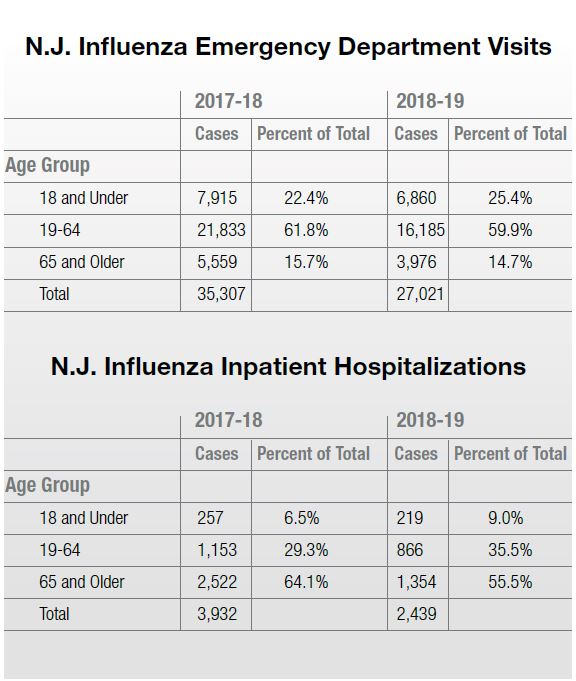The flu (influenza) is a respiratory illness caused by the human influenza viruses. The two main types of influenza viruses that spread among people are Types A and B, and are the cause of seasonal flu epidemics.
Per CDC estimates, approximately 3 to 11 percent of the U.S. population experiences a symptomatic flu illness each year, with an average around 8 percent. Infected individuals are most contagious in the first three to four days after the illness begins. Individuals often experience symptoms around two days after infection and can remain contagious for up to five to seven days after that period. The flu can be spread via tiny droplets, which are released when someone sneezes, coughs, or even talks.
Annual vaccinations remain the best way to prevent the flu, according to the CDC.
Flu season runs from October to May, with most cases being reported from late December to early March. Like the flu itself, the vaccine is seasonal. Each year, the flu vaccine attempts to match, and therefore protect against, what the most common circulating influenza strains are predicted to be for the upcoming season. Due to this factor, its effectiveness varies season to season. The main cause of seasonal mutations in the influenza virus is antigenic drift, which involves relatively small genetic changes in the virus. Per the CDC, the flu vaccine reduces the risk of influenza by 40 to 60 percent when the circulating flu viruses are well-matched to the flu vaccine.
The 2017-18 influenza season in the United States was one of the most severe in recent memory. High rates of influenza during the 2017-18 season reflect the low vaccine effectiveness that season, which the CDC estimated at 38 percent. By comparison, the preliminary effectiveness of the flu vaccine for the 2018-19 season is estimated at 47 percent.
The CDC’s own estimates of the burden associated with the last two flu seasons help demonstrate the severity of the 2017-18 season compared to 2018-19. The estimated burden due to influenza for the 2017-18 season included:
- 49 million flu illnesses
- 960,000 flu hospitalizations
- 79,000 flu deaths.
By comparison, preliminary estimates for the 2018-219 flu season include the following:
- 37.4 to 42.9 million flu illnesses
- 531,000 to 647,000 flu hospitalizations
- 36,400 to 61,200 flu deaths.
Serious flu complications can result in hospitalization or even death. Young children, the elderly, and individuals with certain health conditions are at a higher risk of serious complications. While those with the highest risk of developing serious complications from the flu include individuals age 65 and older, there is an increasing recognition for the need to account for the diversity within the elderly population in regard to health. Based on a study by the CDC, hospitalization rates for influenza among adults aged 85 years and older were two-to-six times higher compared to those aged 65-74 years.
A look at claims data from New Jersey acute care hospitals supports the CDC’s findings about the virulence of the 2017-18 flu season compared to that of the following year. On the inpatient side, hospitals throughout the state collectively discharged 61 percent more patients with an influenza-related primary diagnosis from Oct. 1, 2017, to March 31, 2018, than during the same six-month period in the subsequent year. This finding is consistent with the CDC’s estimated number of hospitalizations due to influenza for these two flu seasons. The approximately 960,000 hospitalizations attributed to the 2017-18 flu season is 63 percent greater than the average (589,000) hospitalizations estimated by the CDC for 2018-19.

Source: NJ Hospital Discharge Data Collection System
The flu, like many other diseases, presents greater risks from complications for elderly individuals. With that in mind, CHART analyzed the New Jersey hospital discharge data by age group. Not surprisingly, patients 65 years and older comprised more than 55 percent of inpatient influenza cases for the 2018-19 flu season and 64 percent of inpatients for the 2017-18 season. Again, this finding parallels results at the national level, including the CDC’s finding that between 50 and 70 percent of seasonal flu-related hospitalizations have occurred among people 65 years and older.
While being most dangerous to the elderly and the young, the flu also inflicted New Jersey’s healthiest component of society. In 2017-18, an unanticipated number of individuals between the ages of 19 and 64 visited New Jersey hospital emergency departments seeking treatment for the flu. Compared to the following year, emergency department visits for influenza-related diagnoses were 31 percent higher during the 2017-18 season. However, unlike the inpatient activity, patients seeking care at emergency departments and not subsequently admitted to the hospital were predominantly younger. The cohort between the ages of 19 and 64 comprised 62 percent of all total influenza-related emergency department visits for the 2017-18 season and 60 percent of the total the next flu season.
Hover over chart to see data.
The rate of influenza per 100,000 population has grown significantly in recent years. The most recent data available shows the influenza rate per 100,000 population more than doubling from the prior year – from 152.7 cases per 100,000 population in 2017 to 317.4 in 2018.
Hover over chart to see data.